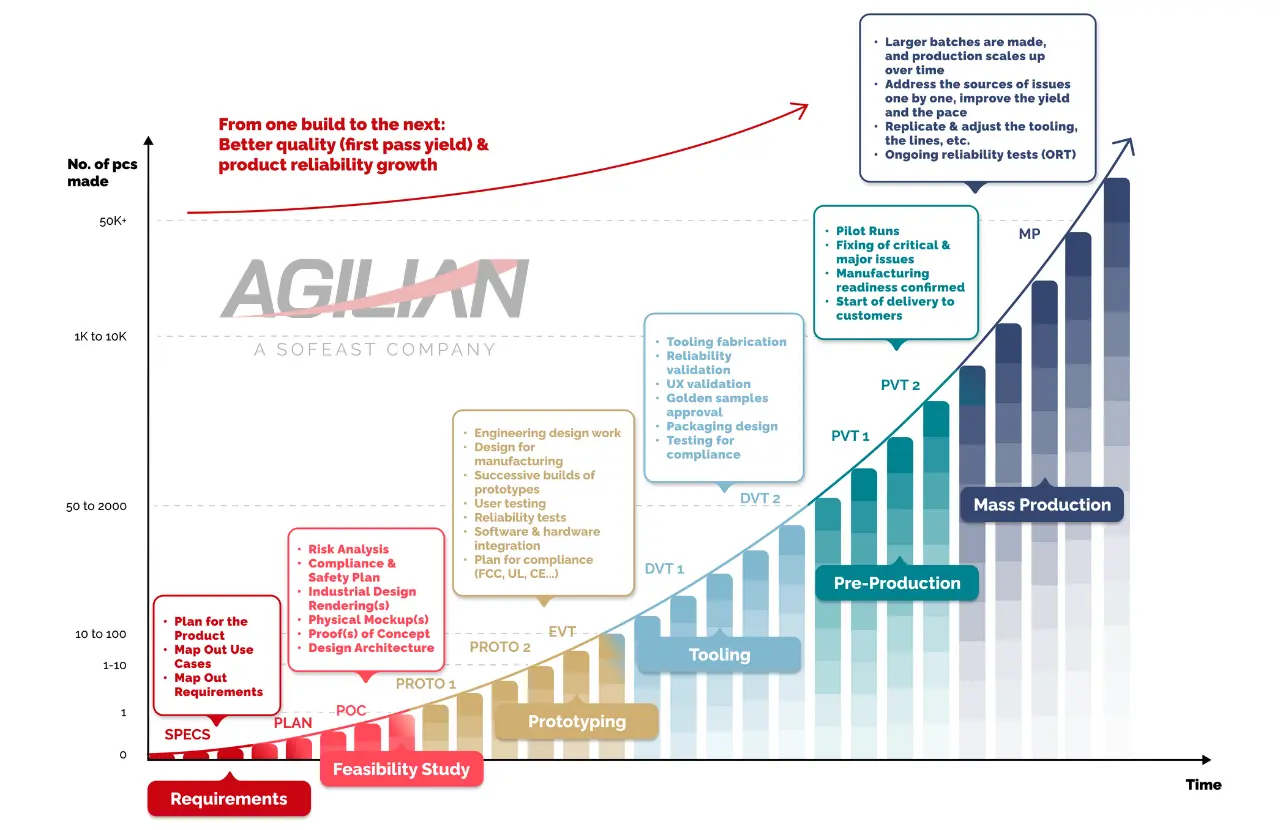When bringing your new product to market, following a structured new product introduction process is critical if you want to reduce risks of:
- Products that are not feasible to make
- Poor quality
- Non-compliant products
- Substandard processes that result in inconsistent production
- Going over budget
- Getting to market late
- Unreliable products in the field
- …and more.
Table of Contents
ToggleReducing risks during the NPI process
The NPI process is complex and filled with various tasks at each phase that really should not be skipped, as missing them increases risks.
We created this video to illustrate how risks are addressed throughout:
How risks are less critical as we move along
As this video shows in its first section, as we move through the process, we address technical risks. You will see that those encountered during the earlier design and development stages are more critical to success than those later on as we approach mass production.
At the start, you must follow a risk-based approach and work on choosing the right design architecture, clarifying UX, product industrial design, select its key components, perform risk analysis, and address the main tech difficulties, as well as dealing with compliance and regulatory issues. You will create proof of concept prototypes and test them, and also speak to specialized suppliers to find out what is possible.
This paves the way to go into prototyping where the engineering design is done. Issues with the product will become clear and should be addressed in new prototype iterations, reducing risks bit by bit. Eventually, you validate the design through environmental and reliability testing, and then the product is ready to head into pre and mass-production.
Here the product design is locked and tooling is made, but manufacturing and testing processes are validated and technical risks that could be caused by them are reduced.

For example, issues with the product design that are not addressed by doing a feasibility study will be very difficult, costly, and time-consuming to correct later on when prototypes have been made, or worse, when the product goes into production. A design on paper or CAD can be changed quickly and easily, but after time and money have been spent to create prototypes or even tooling? Making the same change is a big problem.
What activities are included in the NPI process?
To have some idea of the many helpful tasks involved in each stage of the process that you will need to undertake, explore this visual:

If you would like to explore the NPI process in more detail, watch this video:
How does the NPI process reduce risks?
This graphic illustrates how much risk is reduced by certain actions:
- You start with an idea that has 100% of the risks.
- By documenting specifications and making them as specific as possible risk is reduced a little as it gives clarity to the product development team.
- The feasibility study phase is usually the most impactful. Rough designs are made, users consulted, and it results in the design architecture being a lot more concrete.
- Prototypes are made, validated and tested, perhaps numerous versions, and during this process issues are found and fixed leading to a refined product design. The impact of this stage is even more for products that include a lot of software.
- Tooling is fabricated and products are made that have the same physical properties as will be in mass-production as they’re made with it, reducing risks further compared to prototypes made with other processes, materials, or equipment. This is the time to do reliability, quality, and compliance testing which can surface other issues that should be corrected.
- In pre-production, a pilot run/s happens which will find some of the final issues in the production processes.
- During mass production, the production will be monitored for issues and processes refined for better results. Any returns or problems from the field can also be addressed.
The first three phases are about discovery and the greatest impact on risk-reduction occurs here and there is a lot of trial-and-error to find and fix issues. By the time you go into tooling, these latter three are the delivery phases and the risk reduction opportunities are less significant (although still important) and the risks become more linear.

Real examples of products that failed due to not following a structured NPI process.
No one wants their product to fail to launch. This could mean months or even years of work lost, not to mention a lot of money. Some quite high-profile Kickstarter hardware startups did indeed skip elements of the NPI process, resulting in their failure. For example, the ‘Coolest Cooler’ which raised around US$13M and still failed!

Read more about WHY these interesting products failed so you can avoid their mistakes, in this post: Failed Kickstarter Startups That Didn’t Follow A Structured NPI Process
Need help to bring your new product to market?
Our in-house engineers work on lots of different electro-mechanical products for our customers and we can assist you with the whole process as described above, starting with the feasibility study and industrial design.
Get in touch to talk about your new product with us!
About Renaud Anjoran
Renaud is a recognised expert in quality, reliability, and supply chain issues and is Agilian's Executive VP. He has decades of experience in electronics, textiles, plastic injection, die casting, eyewear, furniture, oil & gas, and paint. He is also an ASQ-Certified ‘Quality Engineer’, ‘Reliability Engineer’, and ‘Quality Manager’, and a certified ISO 9001, 13485, and 14001 Lead Auditor.



